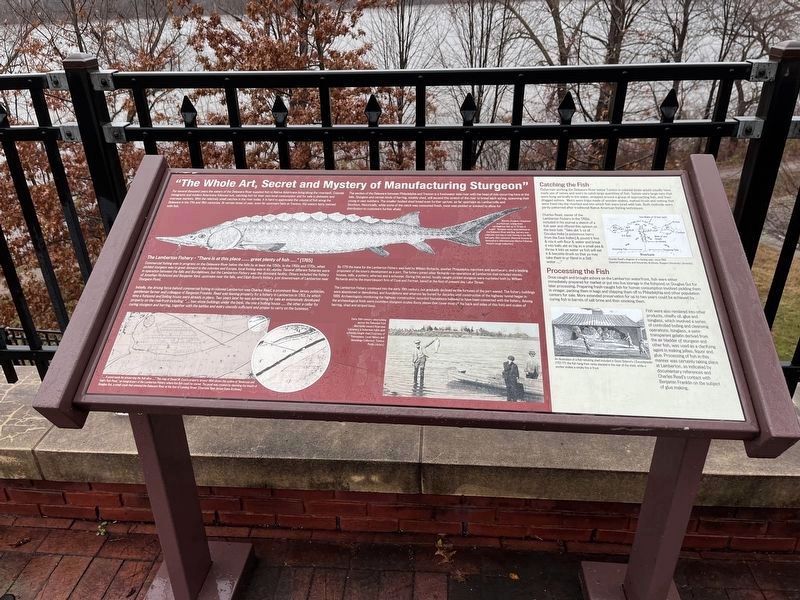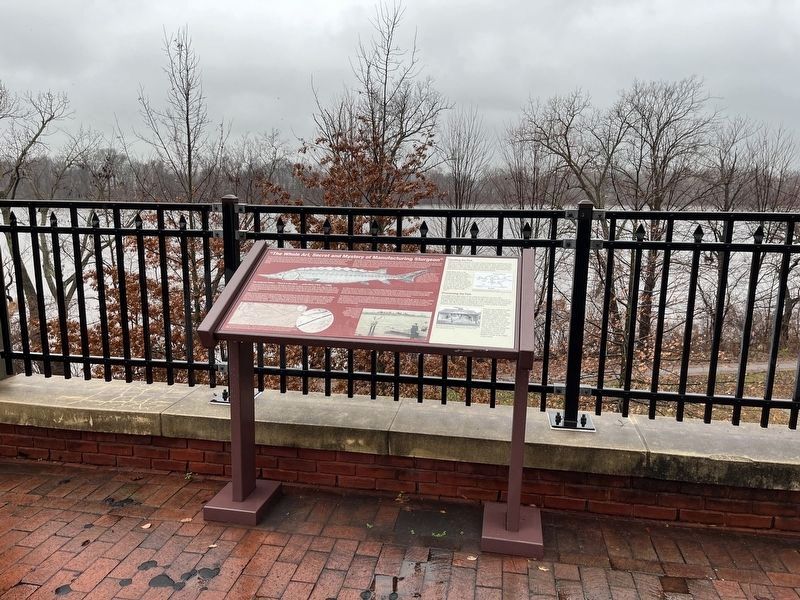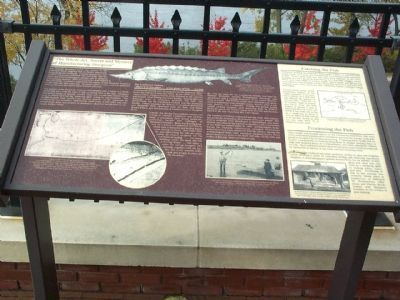South Trenton in Mercer County, New Jersey — The American Northeast (Mid-Atlantic)
"The Whole Art, Secret and Mystery of Manufacturing Sturgeon"

Photographed By Devry Becker Jones (CC0), December 16, 2022
1. "The Whole Art, Secret and Mystery of Manufacturing Sturgeon" Marker
For several thousand years the waters of the Delaware River supplied fish to Native Americans living along the riverbank. Colonial Immigrants and modern Americans followed suit, catching fish for their own local consumption and for sale in domestic and overseas markets. With the relatively small catches in the river today, it is hard to appreciate the volume of fish along the Delaware in the 17th and 18th centuries. At certain times of the year, even far upstream here at Trenton, the waters fairly teemed with fish.
The section of the Delaware between Philadelphia and Trenton is a freshwater tidal river with the head of tide occurring here at the falls. Sturgeon and certain kinds of herring, notably shad, still ascend this stretch of the river to breed each spring, spawning their young in vast numbers. The smaller-bodied shad breed even further upriver, as far upstream as Lambertville and Stockton. Historically, while some of the catch was consumed fresh, most was pickled or smoked to allow for distribution to customers further afield.
The Lamberton Fishery – “There is at this place ….. great plenty of fish …..” [1765]
Commercial fishing was in progress on the Delaware River below the falls by at least the 1750s. In the 1760s and 1770s, when pickled sturgeon was in great demand in the colonies and Europe, local fishing was in its heyday. Several different fisheries were in operation between the falls and Bordentown, but the Lamberton Fishery was the dominant facility. Others included the fishery of Jonathan Richmond and Benjamin Yard, upstream near the falls, and Elijah Bonds fishery, just downstream of Lamberton near Sturgeon Pond.
Initially, the driving force behind commercial fishing in colonial Lamberton was Charles Read, a prominent New Jersey politician, gentleman farmer and colleague of Benjamin Franklin. Read was leasing property for a fishery in Lamberton in 1763, by which time a fishpond and boiling house were already in place. Two years later he was advertising for sale an extensively developed property on the riverfront including: “…. Two stone buildings under the bank, the one a boiling house ….. the other a cellar for curing sturgeon and herring, together with the kettles and every utensils sufficient and proper to carry on the business.”
By 1770 the lease for the Lamberton Fishery was held by William Richards, another Philadelphia merchant and apothecary, and a leading proponent of the town’s development as a port. The fishery joined other Richards-run operations at Lamberton that included stores, houses, mills, a pottery, wharves and a schooner. During this period, locally caught pickled sturgeon were marketed both by William Richards
and by the import/export form of Coxe and Furman, based at the foot of present day Lalor Street.
The Lamberton Fishery continued into the early 19th century, but gradually declined as the fortunes of the port waned. The fishery buildings were abandoned or demolished, and foundations and wharves lay buried for decades until construction of the highway tunnel began in 1999. Archaeologists monitoring the highway construction recorded foundations believed to have been connected with the fishery. Among the archaeological finds were countless sturgeon scutes (bony plates that cover most of the back and sides of this fish) and scales of herring, shad and striped bass.
Catching the Fish
Fishermen working the Delaware River below Trenton in colonial times would usually have made use of seines and weirs to catch large quantities of fish. Seines were large nets that were hung vertically in the water, wrapped around a group of approaching fish, and then dragged ashore. Weirs were traps made of wooden stakes, matted brush and netting that were fixed into the riverbed and int which fish were lured with bait. Both methods were partly patterned after traditional Native American fishing techniques.
Charles Read, owner of the Lamberton Fishery in the 1760s, included in his journal a sketch of a fish weir and offered this opinion on the best bait: “Take

Photographed By Devry Becker Jones (CC0), December 16, 2022
3. "The Whole Art, Secret and Mystery of Manufacturing Sturgeon" Marker
Processing the Fish
Once caught and brought ashore on the Lamberton waterfront, fish were either immediately prepared for market or put into live storage in the fishpond on Douglas Gut for later processing. Preparing fresh-caught fish for human consumption involved pickling them in vinegar, packing them in kegs and shipping them off to Philadelphia and other population centers for sale. More extended preservation for up to two years could be achieved by curing fish in barrels of salt brine and then smoking them.
Fish were also rendered into other products, chiefly oil, glue and isinglass, which involved a series of controlled boiling and cleansing operations. Isinglass, a semi-transparent gelatin derived from the air bladder of sturgeon and other fish, was used as a clarifying agent in making jellies, liquor and glue. Processing of fish in this manner was certainly taking place at Lamberton, as indicated by documentary references and Charles Read’s contact with Benjamin Franklin on the subject of glue making.
Erected 2004 by New Jersey Department of Transportation .
Topics. This historical marker is listed in these topic lists: Industry & Commerce • Natural Resources. A significant historical year for this entry is 1763.
Location. 40° 11.95′ N, 74° 45.522′ W. Marker is in Trenton, New Jersey, in Mercer County. It is in South Trenton. Marker can be reached from New Jersey Route 29. This marker is in South River Walk park which is built over top of Route 29. Touch for map. Marker is in this post office area: Trenton NJ 08611, United States of America. Touch for directions.
Other nearby markers. At least 8 other markers are within walking distance of this marker. "… a Town laid out called Lamberton …" [1773] (here, next to this marker); 1913 (a few steps from this marker); 2005 (a few steps from this marker); 1994 (a few steps from this marker); 1990 (a few steps from this marker); 1973 (a few steps from this marker); 1965 (a few steps from this marker); 1964 (a few steps from this marker). Touch for a list and map of all markers in Trenton.
More about this marker. The marker is in the northern half of the park.
Credits. This page was last revised on February 16, 2023. It was originally submitted on December 26, 2007, by Gary Nigh of Trenton, New Jersey. This page has been viewed 1,473 times since then and 26 times this year. Last updated on February 2, 2021, by Carl Gordon Moore Jr. of North East, Maryland. Photos: 1. submitted on December 18, 2022, by Devry Becker Jones of Washington, District of Columbia. 2. submitted on December 26, 2007, by Gary Nigh of Trenton, New Jersey. 3. submitted on December 18, 2022, by Devry Becker Jones of Washington, District of Columbia. • Bill Pfingsten was the editor who published this page.
